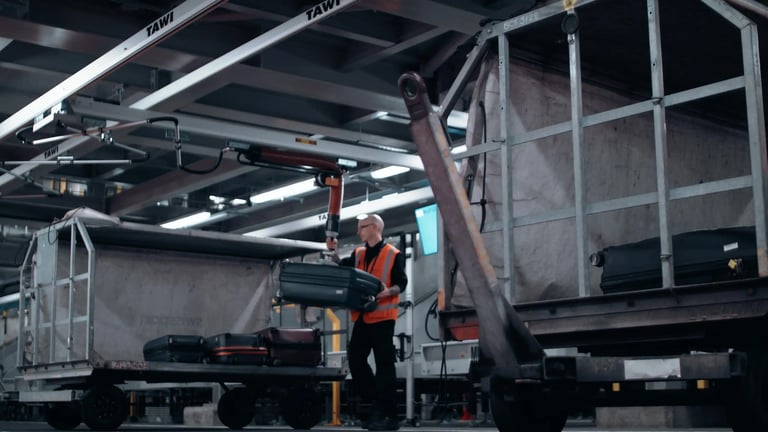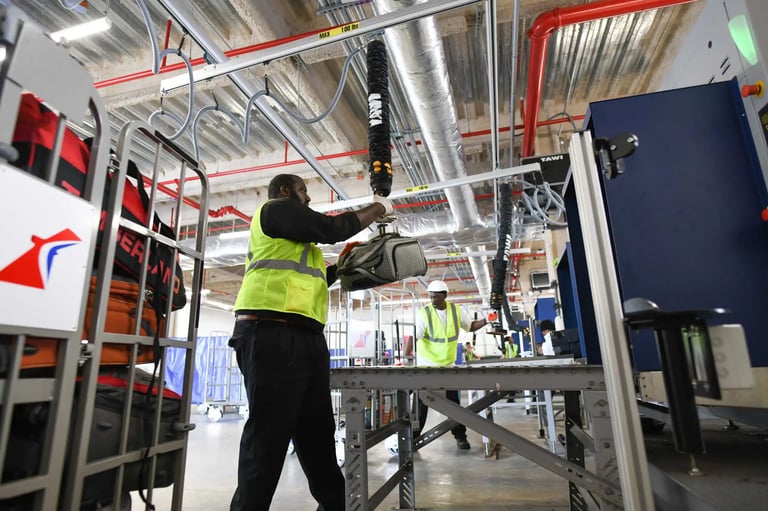Future Trends and Innovations in Airport Baggage Systems

As global air travel continues to expand, airport baggage systems are under increasing pressure to become faster, smarter, and more sustainable. Passenger expectations for seamless, stress-free journeys are driving airports and ground-handling operators to rethink traditional baggage processes.
However, many airports still operate with legacy infrastructure that limits how much they can automate or expand. Major airports may use fully automated baggage systems. However, smaller and mid-sized airports need flexible solutions.
These solutions can improve performance without needing to completely change their facilities. Fortunately, technologies such as vacuum lifting systems are transforming how baggage is handled, improving safety, efficiency, and ergonomics for workers.
Emerging Technologies Shaping the Future of Airport Baggage Systems
More passenger traffic and higher demand for better service require more efficient baggage systems. One significant trend is utilizing automation and robotics in airport operations. Automation can manage a lot of baggage more accurately. It reduces human mistakes and speeds up the check-in and baggage retrieval process.
Artificial Intelligence (AI) and machine learning are playing a vital role. They can help airports predict baggage flow patterns, optimize resources, and improve system performance. They can even anticipate and mitigate issues like congestion, misrouted bags, or breakdowns in the baggage handling system.
The next generation of airport baggage systems is being defined by digitalization, automation, and intelligent connectivity. Here are some of the most impactful trends:
1. Automation and Robotics
Robotic and automated baggage handling technologies are revolutionizing how airports manage increasing passenger volumes. Automation helps move bags quickly and accurately through every stage of the process, from check-in to loading, reducing errors and turnaround times.
2. Artificial Intelligence (AI) and Machine Learning
AI-powered systems can predict baggage flow, identify potential bottlenecks, and optimize resources in real time. By learning from past data, these systems enhance performance and resilience, ensuring smoother operations even during peak travel periods.
3. Automated Guided Vehicles (AGVs)
AGVs use sensors and navigation software to transport baggage autonomously throughout terminals. They minimise human intervention, reduce the risk of mishandling, and lower operational costs. However, workers still need to manually lift when loading and unloading these vehicles. This is an area where semi-automated lifting aids, such as vacuum lifters, can make a big difference in safety and speed.
4. Radio-Frequency Identification (RFID)
RFID tagging enables real-time tracking of luggage throughout its journey, from check-in to arrival. This technology improves visibility, reduces lost or delayed baggage, and enhances passenger satisfaction.
5. Internet of Things (IoT) Integration
The IoT links all parts of the baggage handling system. This includes conveyor belts, sorting areas, check-in counters, and ground staff. Together, they form one intelligent network. With continuous data exchange, airports can monitor and optimize performance, reduce downtime, and streamline coordination between teams.
Building Sustainable and Efficient Baggage Systems
Sustainability has become a major driver in airport operations. Modern baggage systems are being redesigned to consume less energy, minimize emissions, and improve working conditions.
Electric and battery-powered AGVs are replacing older fuel-based vehicles, while smart automation reduces energy use across operations. In addition, ergonomic innovations like TAWI’s vacuum lifting solutions contribute to sustainability by protecting workers’ health, reducing injuries, and improving productivity.

By enabling operators to handle baggage with minimal strain and effort, vacuum lifters extend workforce longevity and reduce downtime. This creates a safer, more sustainable handling environment.
Don’t Get Left Behind: Upgrade Your Airport Baggage Handling Today
As technology continues to evolve, manual baggage lifting is becoming a thing of the past. To remain competitive, airports must adopt solutions that combine automation, safety, and efficiency. Explore more in our article “the true cost of getting baggage handling wrong”.
TAWI has extensive experience supporting airport baggage handling operations worldwide. With over 800 installations across 60 airports and cruise terminals, we design our vacuum lifting systems to integrate seamlessly with existing baggage infrastructure. Making it easy to enhance operations without costly overhauls.
Whether you manage a large international terminal or a regional airport, TAWI can help you achieve smoother, faster, and safer baggage handling.
Learn more about our airport baggage solutions and discover how we can help your operations.